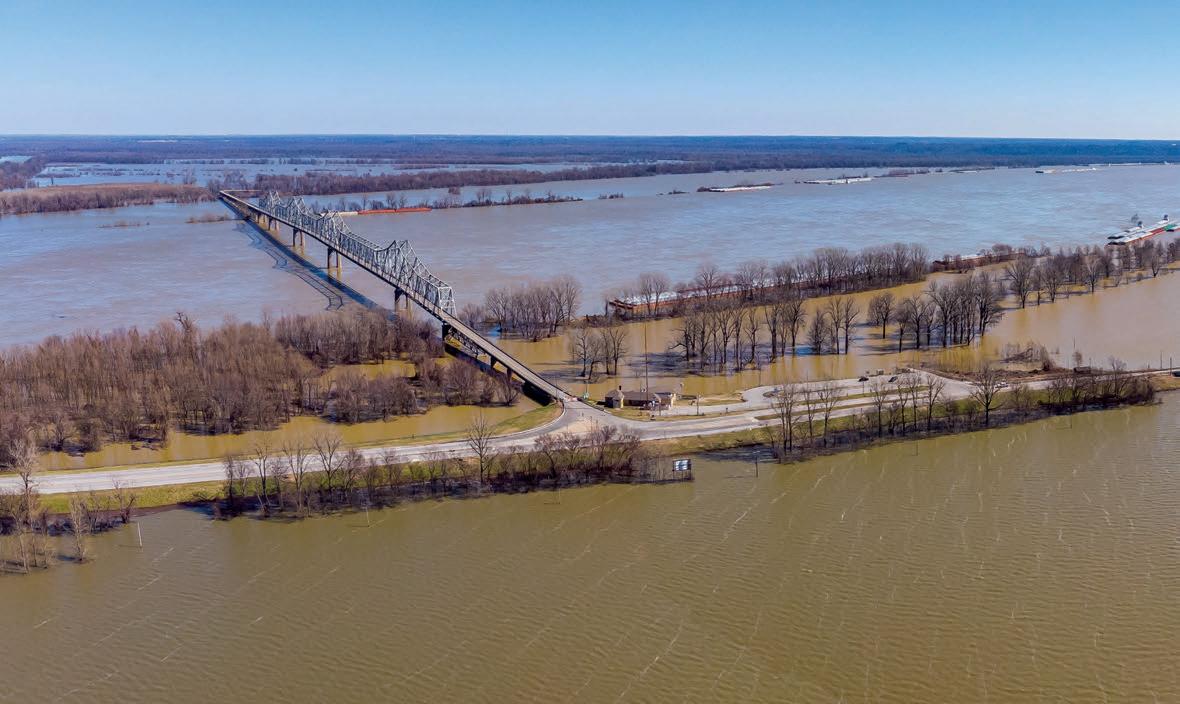
When the flooding ends and the river recedes back to its channel, it leaves behind silt on the floodplain. Silt is a fine dirt that holds water. The cycle of flooding, depositing silt, and receding waters makes the soil around rivers particularly good for growing things.
But as people began living permanently in the low-lying plains around the Mississippi, flooding on the river became destructive. When the Mississippi floods today, millions of people are affected. And because the river's drainage system covers more than 40 percent of the United States, wet weather in one section of the country can cause serious floods many miles away.
For example, in December 1926, snowstorms blanketed Montana, South Dakota, and Minnesota. Then in March 1927, blizzards buried Wyoming, Colorado, and Nebraska and parts of Texas, Oklahoma, and Missouri. Farther south, it rained. That spring, melting snow fed into nearby rivers, which overflowed their banks. Most of that water eventually reached the Mississippi.
By the time the Mississippi River rolled through Arkansas, Mississippi, and Louisiana that year, it was so swollen that the levees crumbled under the immense weight of the water. The river spilled into the farmlands and towns of the Mississippi River Delta. It filled 27,000 square miles, the size of four New England states. More than 600,000 people lost their homes. An estimated 500 people lost their lives. It was the biggest flood on record to hit the Lower Mississippi.
Esta historia es de la edición April 2023 de Cobblestone American History Magazine for Kids.
Comience su prueba gratuita de Magzter GOLD de 7 días para acceder a miles de historias premium seleccionadas y a más de 9,000 revistas y periódicos.
Ya eres suscriptor ? Conectar
Esta historia es de la edición April 2023 de Cobblestone American History Magazine for Kids.
Comience su prueba gratuita de Magzter GOLD de 7 días para acceder a miles de historias premium seleccionadas y a más de 9,000 revistas y periódicos.
Ya eres suscriptor? Conectar

Putting the Pieces Together
Americans needed to begin to put the past behind them, come together, and plan for the future in the spring of 1865. But Abraham Lincoln, the man best equipped to lead them and who had hoped to restore the country as smoothly and peacefully as possible, had been assassinated.

LAST SHOTS
The last Confederate forces in the Civil War didn’t surrender in the spring of 1865 or on a battlefield.

AND IN OTHER 1865 NEWS
A group of African Americans stop at the White House’s annual public reception on January 1, where they shake hands with President Abraham Lincoln.

A Plot to Kill President the
For several months, actor John Wilkes Booth’s band of conspirators had plotted to capture President Abraham Lincoln and hold him hostage in exchange for Confederate prisoners.

Let the Thing Be Pressed
In June 1864, Union Lieutenant General Ulysses S. Grant began a nearly 10-month campaign in Virginia.

HEALING THE NATION
President Abraham Lincoln took the oath of office for the second time on March 4, 1865.

A Helping Hand
The spring season is hard in any agricultural society. Plants and animals are too small to eat.

WAR SHERMAN-STYLE
As far as Union Major General William T. Sherman was concerned, the Civil War had gone on long enough.

PEACE TALKS
The fall of Fort Fisher made clear that the Confederacy’s days were numbered. Southerners were tired and hungry.

FORT FISHER'S FALL
Outnumbered Confederate soldiers inside Fort Fisher were unable to withstand the approach of Union troops by land and the constant Union naval bombardment from the sea.